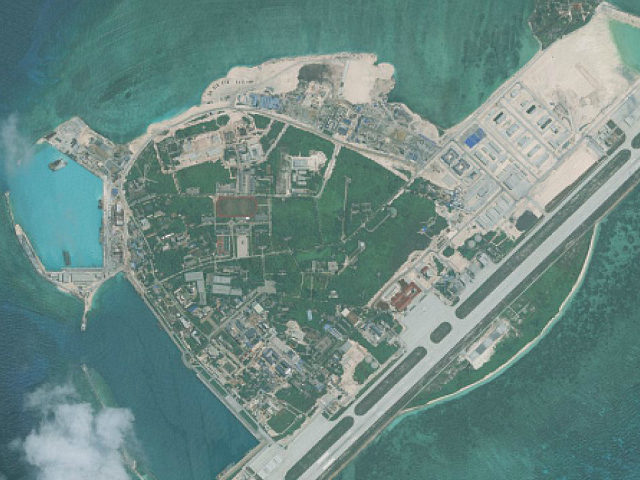A report published this week unveils significant Chinese development of military constructions and placement of new naval and aerial military assets in the Paracel Islands, a disputed territory in the South China Sea.
The Center for Strategic and International Studies’ (CSIS) Asia Maritime Transparency Initiative published new photos of the islands that make up the Paracels, showing significant construction on all of them. The most developed island is Woody Island, which China has long used as its central base in the region. Woody Island, CSIS notes, now possesses “an airstrip, hangars, and a deployment of HQ-9 surface-to-air missile batteries.”
CSIS found seven new harbors on the islands, as well as one under construction, and five helipads.
The South China Morning Post describes the constructions revealed in the new satellite photos as “extensive” and clearly for military use. “Not all of China’s outposts in the Paracels currently house significant infrastructure, and many contain no more than one or two buildings… but the presence of small buildings and construction materials suggests China may be preparing to expand those features,” CSIS said in their report.
The Chinese government claims most of the South China Sea, including the Spratly Islands, Paracel Islands, and Scarborough Shoal. The territory Beijing claims overlaps with the sovereign territories of the Philippines, Vietnam, Malaysia, Brunei, Taiwan, and the waters off Natuna Island, Indonesia.
The Chinese government focused its efforts on military constructions on the Spratly Islands for months, even sending a popular nationalist folk singer to celebrate the completed construction of new facilities there. Now it appears the communist government in Beijing has refocused its efforts to the Paracels, which Vietnam claims as its own.
While the Communist Party rules both parties, the Vietnamese government has objected to China usurping its territory and began its own construction of military assets in the region last year. Long before Vietnam began its comparatively small constructions, however, Beijing had already commissioned the construction of an expanded aircraft runway on Woody Island.
Vietnamese citizens appear to approve of Hanoi’s challenge to China — as recently as late January, dozens of Vietnamese people gathered to protest China’s presence in the Paracel Islands, holding up signs reading, “down with the invaders,” and referring to China as an “enemy.” The protest was notable for the minimal police intervention it appeared to attract, a rarity in the communist country.
While Chinese officials have insisted for years that the South China Sea has been under Beijing’s control “since ancient times,” the Permanent Court of Arbitration at the Hague found last year that China’s claims over the territory are invalid and the establishment of military bases in the area are illegal. This has not stopped China from continuing to expand its presence in the region. Allies like Russia have also come to China’s defense, claiming Beijing has a right to colonize the region.
The United States has persisted as a voice of objection to China’s actions in the region, in addition to the nations whose sovereignty China has infringed upon. Under President Barack Obama, the U.S. Navy conducted multiple “Freedom of Navigation” operations in the region, intended to enforce the United Nations’ Convention on the Law of the Sea (UNCLOS), which requires free international passage in these waters.
President Donald Trump’s administration has vowed to take a harder line in defense of allies in the region. “If those islands are, in fact, in international waters and not part of China proper, yeah, we’ll make sure we defend international interests from being taken over by one country,” Press Secretary Sean Spicer said in one of his first press briefings on the job in January. Defense Secretary James Mattis reportedly reassured allies in South Korea and Japan last week that the United States would work to contain Chinese colonization in the region, which threatens neighboring countries who do not make claims within the South China Sea.
In response to Spicer’s remark, the Chinese Foreign Ministry told the United States to stay out of the dispute. “The US is not a claimant in the related disputes in the South China Sea,” spokeswoman Hua Chunying told reporters. “We urge the US side to respect the reality, to be cautious in its remarks and actions, so as to avoid undermining the peace and stability in the region.”
Washington’s assurances it will not allow China to usurp the region preceded comments from the government of the Philippines, which appeared to have come to an agreement benefitting China in recent months, that Manila is concerned about Beijing’s moves in the Scarborough Shoal. Under President Benigno Aquino, the Philippines won the aforementioned Hague case. Under current president Rodrigo Duterte, however, Manila has attempted to establish a closer bond with Beijing, overlooking some Chinese moves in Philippine waters.
That appeared to end this week when Defense Minister Delfin Lorenzana told the Agence France-Presse that Manila will be working to oppose China’s “occupation” in the Scarborough Shoal. “They occupied three islands there (in the Spratlys) plus they are trying to get Scarborough. So to us that is unacceptable,” he said.
“If we allow them, they will build. That’s very, very disturbing. Very much (more) disturbing than Fiery Cross because this is so close to us,” Lorenzana said of new constructions.

COMMENTS
Please let us know if you're having issues with commenting.